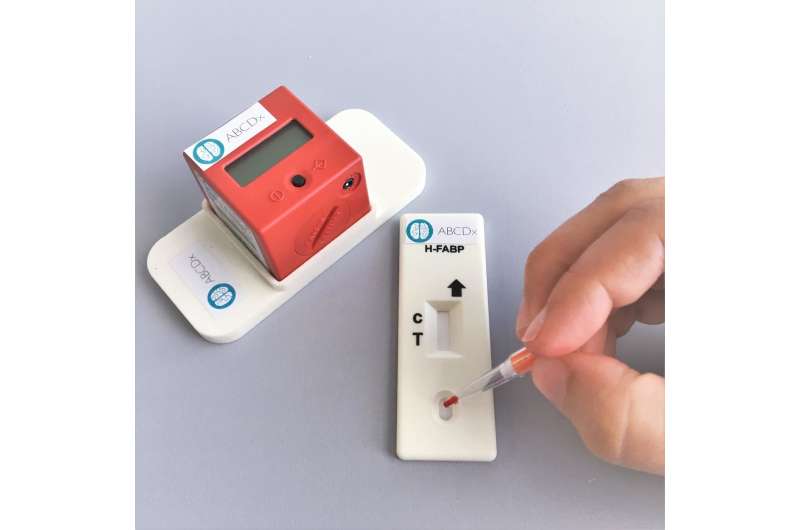One drop of blood is enough for TBIcheck to diagnose a possible mild brain trauma. If a line appears below the control line, the injured person will have to go to the hospital for a CT scan. Credit: UNIGE
Every year in Europe, 3 million people are admitted into hospitals for suspected mild traumatic brain injury (mTBI) cases. Yet 90 percent of these patients detect no trauma. Today, the only reliable diagnosis is the CT scan, which is only available in some hospitals.
Researchers from the University of Geneva (UNIGE), in collaboration with the Hospitals of Barcelona, Madrid and Seville, have developed a small device – the Point-of-Care Test (POCT)—that analyses the level of proteins in a single drop of blood to diagnose the possibility of a mild traumatic brain injury. This innovation, described in PLOS One, will not only relieve emergency departments, free patients from often long waits, but also save on costly medical examinations.
Head injury can cause symptoms such as blurred vision, vomiting, loss of consciousness or memory for about 30 minutes. There is then a risk of mild cerebral trauma, which represents more than 90 percent of brain injuries admitted to hospitals. But is there really a brain lesion? Or are these symptoms merely the consequence of the violence of the shock, of which will ultimately only leave a bump behind?
Today, the injured patients have to go to the emergency rooms of hospitals equipped with a CT scanner, an expensive examination that detects the presence or absence of brain trauma via X-rays. It often takes a long time for the majority of patients to return home without risk of sequelae, except for bad memories.
Find biomarkers for light traumas
"We wondered if it was possible to isolate certain proteins whose presence in the blood increases in the event of mild traumatic brain injury," explains Jean-Charles Sanchez, professor at the Department of Internal Medicine of Specialties and the Biomarkers Centre of the Faculty of Medicine of the UNIGE. "Our idea was to find a way to do a quick examination that would allow us to determine whether an athlete can return to the field or if his condition requires hospitalization," he adds.
During a shock to the head, brain cells are damaged and release proteins, increasing their level in the blood. Scientists at UNIGE and Spanish hospitals compared the blood of patients admitted for mild traumatic brain injury but diagnosed as negative with that of patients actually suffering from a brain lesion. Using proteomic analyses, which can quantify thousands of proteins simultaneously and observe variations in their levels in the blood, the researchers gradually isolated four molecules indicating the presence of a brain injury: H-FABP, Interleukin-10, S100B and GFAP. "We have noticed that the H-FABP level alone makes it possible to confirm that there is no risk of trauma in one third of patients admitted after a shock," says Jean-Charles Sanchez. The rest of the patients will have to undergo a CT scan to confirm the diagnosis.
It was still necessary to develop a device that could be used everywhere, quickly and simply, and that could be available in pharmacies or sports halls. "When a person has an accident on a mountain, few clinics can do a CT scan," notes the Geneva researcher. His team has developed a rapid diagnostic test called TBIcheck, inspired by the principle of pregnancy testing. By placing a single drop of blood on the well of a small plastic case, the patient knows within 10 minutes whether there is a risk of mild trauma, namely whether or not his H-FABP level is higher than 2.5 nanograms per millilitre of blood. "If a line appears, the injured person must go to a hospital for a CT scan, if there is nothing, he can go home safely," Jean-Charles Sanchez says. In case of doubt, a small reader can be installed on TBIcheck. It will display the word "positive" or "negative" and send the result to the patient's or caregiver's smartphone via Bluetooth.
Commercialization planned for beginning 2019
These results, patented by UNIGE and awarded the Prix de l'Innovation Academy in December 2017, will be marketed from 2019 by ABCDx, a start-up founded four years ago by Jean-Charles Sanchez of UNIGE and Joan Montaner of Vall d'Hebron Hospital in Barcelona, co-authors of this study.
"Today, our research shows that the results are even more accurate when we combine H-FABP and GFAP levels," says Jean-Charles Sanchez. "We are currently preparing an even more effective TBIcheck, which will allow 50 percent of patients to be sent home, but which requires an increase in the sensitivity of the test that receives the blood." ABCDx's ultimate goal is to bring to market biomarkers capable of diagnosing brain trauma, stroke and aneurysms. "Biomarkers are a mine of information on patients' state of health, it is up to us to decode them," concludes the Geneva researcher.
More information: Linnéa Lagerstedt et al. Combining H-FABP and GFAP increases the capacity to differentiate between CT-positive and CT-negative patients with mild traumatic brain injury, PLOS ONE (2018). DOI: 10.1371/journal.pone.0200394
Journal information: PLoS ONE
Provided by University of Geneva























